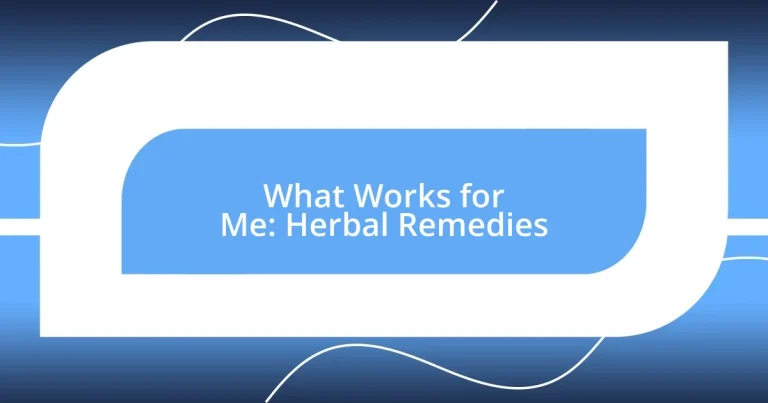Key takeaways:
- Herbal remedies, like chamomile and peppermint, not only promote physical health but also enhance emotional well-being through rituals and scents.
- Preparing herbal remedies at home fosters creativity, mindfulness, and a deeper connection to nature, making the process as therapeutic as the remedies themselves.
- Awareness of individual sensitivities and potential interactions with medications is crucial for safe herbal usage; self-education and keeping a journal can enhance this journey.

Understanding Herbal Remedies Benefits
Herbal remedies offer a treasure trove of benefits that often go beyond what we might expect. For instance, I still remember the time I turned to chamomile tea to ease my anxiety after a particularly stressful week. The warm, fragrant infusion not only helped calm my nerves but also provided a comforting ritual that felt nurturing—something that pharmaceuticals often miss.
One of the most fascinating aspects of herbal remedies is their ability to harmonize with our body’s natural processes. Have you ever noticed how a simple peppermint tea soothes an upset stomach? It’s a small but powerful reminder that nature has its way of supporting our health in ways that feel intuitive. When I experience digestive discomfort, I reach for this natural remedy, and it never ceases to amaze me how quickly it works; it’s almost like our bodies have a secret language with these plants.
Additionally, there’s a profound emotional connection to herbal remedies that can enhance their effectiveness. I’ve found that when I incorporate plants like lavender or rosemary into my daily routine, they don’t just serve a medicinal purpose—they create a meaningful atmosphere that promotes relaxation and mindfulness. Isn’t it fascinating how the scent of a herb can evoke memories or feelings? It’s as if these remedies bridge the gap between physical health and emotional well-being, making them invaluable.
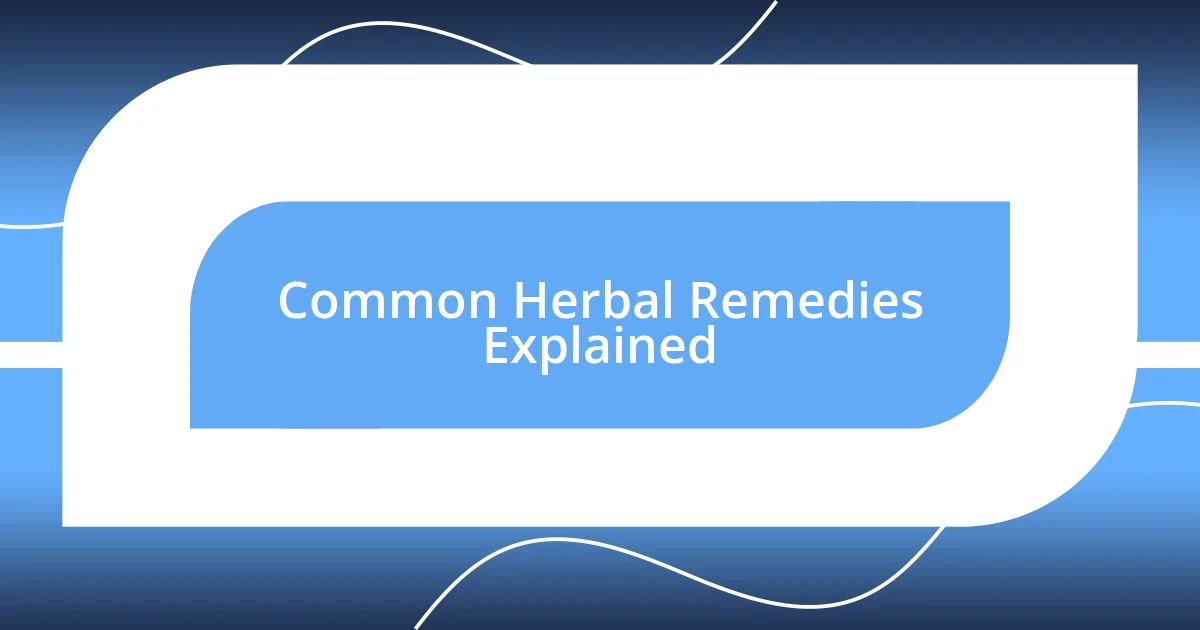
Common Herbal Remedies Explained
When I think about common herbal remedies, a few key players immediately come to mind. For example, ginger is an everyday favorite in my kitchen. I often make ginger tea when I’m feeling a cold coming on, and it never fails to provide warmth and comfort. The spicy kick not only helps soothe my throat but also supports my immune system. And I can’t forget how it invigorates the senses, reminding me of distant travels and the climates where ginger thrives.
Here’s a quick look at some common herbal remedies and what they offer:
- Chamomile: Commonly used for relaxation and sleep; its gentle nature makes it a bedtime favorite for many.
- Peppermint: Not just for upset stomachs, its refreshing scent can also aid concentration and mental clarity.
- Ginger: Known for its anti-inflammatory properties; it’s often used to alleviate nausea and digestive discomfort.
- Lavender: Praised for its calming effects; the aroma alone can transform a stressful day into a soothing evening.
- Echinacea: Often taken to fend off colds; it’s believed to boost the immune system when you feel under the weather.
These little botanical heroes really do more than just sit on the shelf; they hold memories, capabilities, and sometimes even a bit of magic in how they support our well-being.
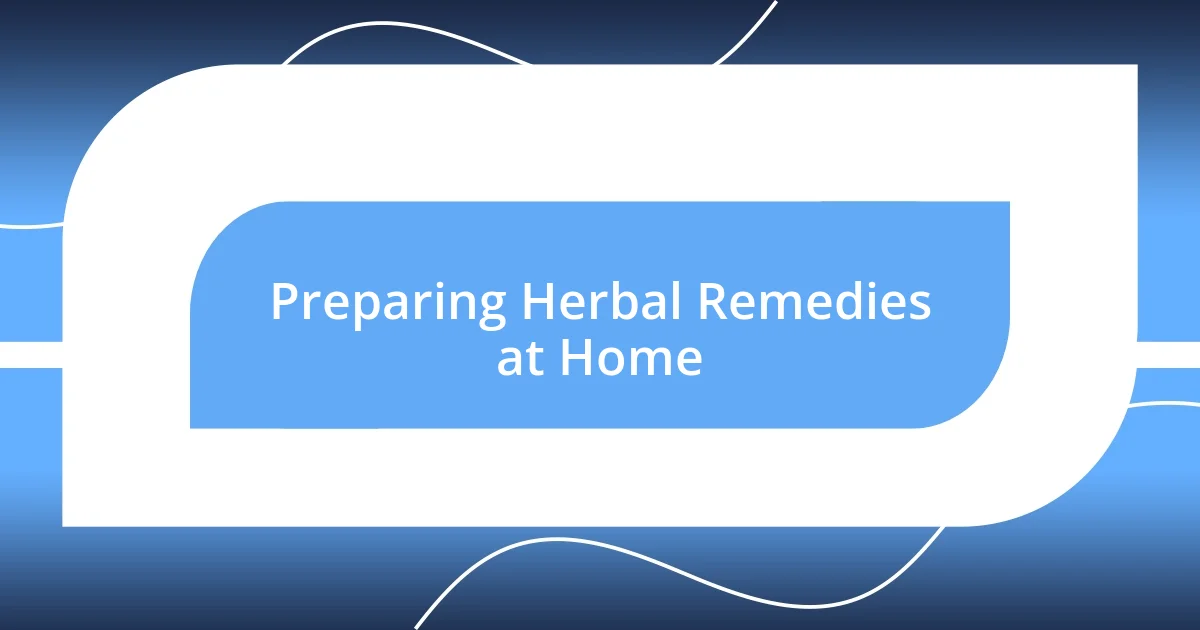
Preparing Herbal Remedies at Home
Herbal remedies can be both fun and rewarding to prepare at home. I remember the first time I decided to make my own herbal oil. I took a handful of dried calendula flowers, mixed them with olive oil, and set the jar in a sunny window for a couple of weeks. When I finally strained the mixture, I was amazed by the vibrant color and calming scent. It felt special to create something so nurturing from scratch, and using it on my skin afterward was incredibly satisfying.
Creating herbal infusions or tinctures can also feel like a personal journey through flavors and aromas. When I first attempted to make a mint-infused simple syrup, it seemed like a small task—but the outcome transformed my summer drinks into a refreshing experience. Just a few sprigs of fresh mint from my garden, hot water, and sugar were all it took. I could customize the sweetness and let the infusion steep for just the right duration. This hands-on approach allowed me to connect with the plant in a way I hadn’t before, enhancing both the flavor and my appreciation for the simple joys of nature.
Ultimately, preparing herbal remedies at home invites creativity and mindfulness into our lives. Whether I’m drying herbs for later use or experimenting with new combinations, each step in the process is a lesson in patience and care. I’ve found that the act of creating these remedies is just as therapeutic as the benefits they provide. Don’t you think there’s something meditative about chopping herbs or simmering a potion on the stove? The experience itself can be as rewarding as the remedy.
| Herbal Preparation Method | Key Ingredients |
|---|---|
| Infusion | Dried or fresh herbs, hot water |
| Tincture | Dried herbs, alcohol (like vodka) |
| Oil infusion | Dried herbs, carrier oil (like olive oil) |
| Salves | Dried herbs, beeswax, carrier oil |
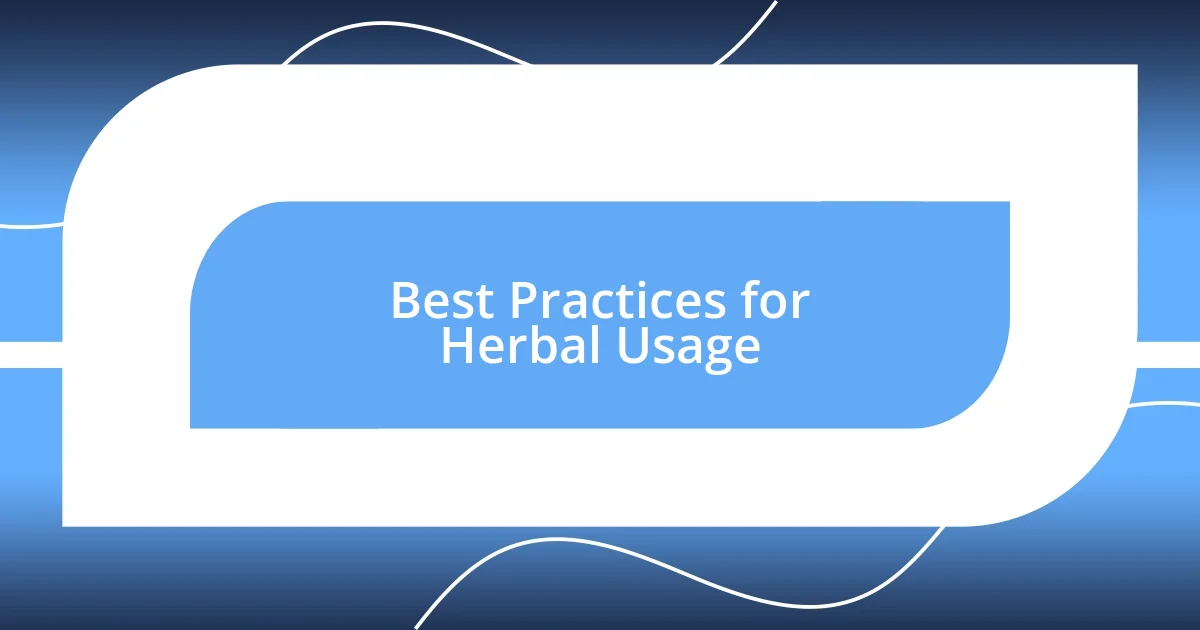
Best Practices for Herbal Usage
It’s crucial to approach herbal remedies with awareness and intention. I remember one day when I was feeling under the weather, and instead of reaching for over-the-counter meds, I decided to steep some echinacea and honey. While sipping that warm, soothing brew, I felt connected to the long history of herbal medicine and appreciated the way nature provides for us. I often ask myself, “How can something so simple have such profound effects?” It reinforces my belief in the power of mindful consumption.
Another best practice is understanding individual sensitivities and potential interactions. I once made the mistake of mixing peppermint and ginger in a concoction, thinking it’d be a delightful blend. While both herbs are fantastic on their own, my stomach didn’t quite appreciate the combination! Learning to listen to my body and recognizing how it responds to different herbs has been part of my journey. It’s fascinating how everyone’s chemistry is unique, isn’t it? I encourage anyone exploring herbal remedies to start with small amounts and observe how their body reacts.
Furthermore, sourcing quality herbs is essential for effective remedies. I vividly recall visiting a local farmers’ market, where the vibrant colors and rich aromas of fresh herbs captivated me. The vendor shared stories about his organic growing practices, and I felt reassured about the quality I was purchasing. It’s experiences like these that remind me of the importance of connecting with growers. Knowing where your herbs come from can enhance the efficacy and safety of your remedies, ensuring that you’re embracing nature’s gifts in the best possible way.

Potential Risks and Side Effects
When diving into the world of herbal remedies, it’s vital to be aware of potential risks. I learned this the hard way after preparing a large batch of herbal tea with a blend of herbs I’d never tried before. My excitement quickly turned to concern when I experienced an unexpected reaction—stomach cramps and nausea. It was a stark reminder that even natural substances can have strong effects, and not all herbs are compatible with each other or our bodies.
Additionally, some herbal remedies can interact with medications, leading to unintended consequences. For instance, I once enjoyed a lovely turmeric latte, unaware that it might amplify the effects of my blood thinners. After a trip to the doctor, I realized how crucial it is to inform healthcare providers about herbal usage. Have you ever thought about how herbal interactions could be just as significant as those with conventional drugs?
Ultimately, I believe that self-education and mindfulness are key to safe herbal practices. I’ve found that keeping a journal of my experiences helps me track what works and what doesn’t. It’s like crafting a personal map of my herbal journey, where I can reflect on any reactions or changes I notice. This process of documenting not only brings awareness but also creates a deeper connection to the remedies I choose to incorporate into my life. Why not start your own herbal journal, too? You might discover insights about your body that you hadn’t noticed before!
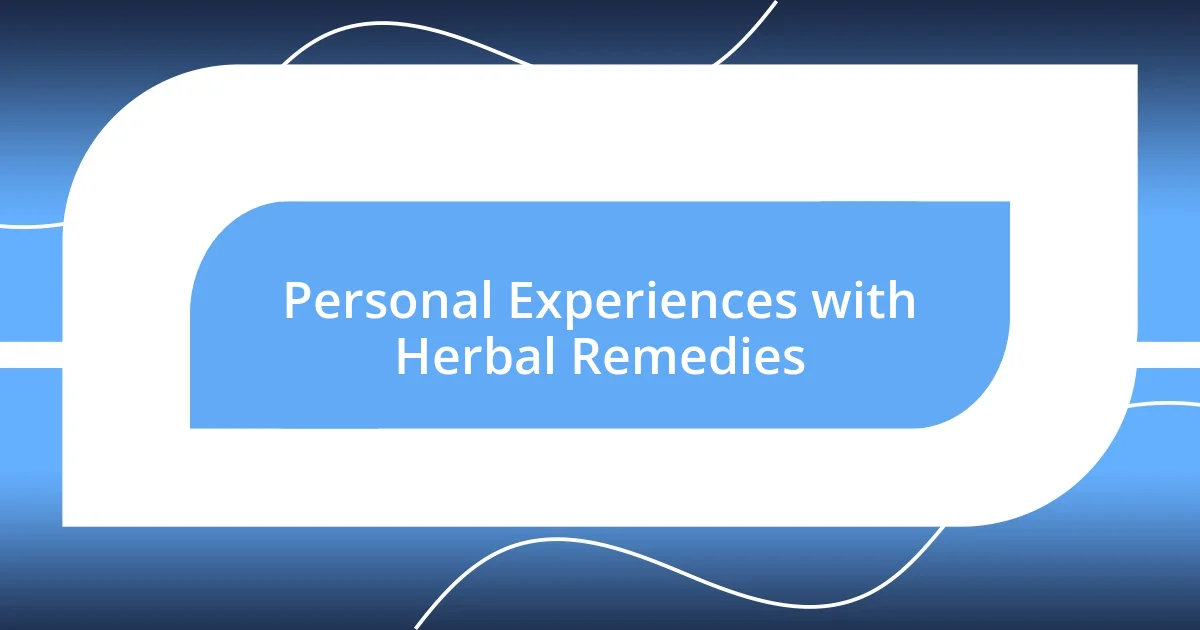
Personal Experiences with Herbal Remedies
I often reflect on my first experience with chamomile tea. On a particularly stressful night, I brewed a cup and settled down with a good book. As I sipped the soothing golden liquid, I felt my worries slowly melt away. That moment made me realize how powerful a simple herbal remedy could be for mental clarity. Have you ever had a drink that felt like a warm hug? For me, chamomile became my go-to for relaxation.
One time, I tried a homemade elderberry syrup during flu season, thinking it would mimic the protective qualities of vaccines. It was fascinating to gather the berries, simmer them with spices, and watch the mixture turn into a deep, mesmerizing hue. I felt a sense of accomplishment, like I was participating in an age-old tradition. However, the real test of my faith came when, despite my efforts, I caught a slight cold. This experience taught me that while herbal remedies can be beneficial, they’re not foolproof. Have you ever felt let down by something you were excited about? It’s all part of the learning curve.
I also remember the initial skepticism I had towards nettle tea. Friends raved about its health benefits, but it sounded so odd to me at first. When I finally decided to try it, I was pleasantly surprised by its earthy flavor. The best part? I felt rejuvenated the next day! That little triumph reminded me of the importance of keeping an open mind. Have you ever needed to push past your initial doubts? I think it’s moments like these that truly deepen our relationship with herbal remedies.












